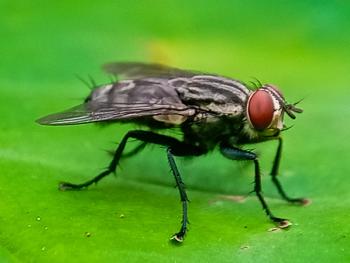
Focus on residual activity: Case study data reveal a clearer flea control picture
A dog in Tampa, Fla., had a severe flea infestation. An area flea-counting system was used to evaluate pet flea counts.
If one of your veterinary patients has a severe flea infestation, you'll likely help the owners take control of the situation with flea-control products. Take a look at this data from a case handled by veterinary parasitologist Dr. Michael Dryden of a dog in Tampa, Florida.1 In this case, direct control on the dog was attempted with a fipronil-(s)-methoprene topical spot-on given on days 0, 28 and 56. (This example is likely representative of other outlier cases involving flea control with imidacloprid, selamectin, spinosad, metaflumizone or other veterinarian-recommended products.) To quantify flea counts in the environment, two intermittent-light flea traps were placed in two rooms in the home for 16 to 24 hours at each counting period.
“Something isn't working here...”
Around day 21 you or your client might think, “Something isn't working here. Flea counts are up.” Flea resistance to the topical product may even be suspected.
But not so fast, says Dryden. “Keep in mind that the fleas collected in intermittent-light flea traps on days 7, 14, 21 and 28 were likely produced from flea eggs laid before treatment was initiated,” he says. “One of the biggest unknowns in a household is how many flea eggs were laid before treatment was initiated and what percentage of those eggs will develop into adult fleas. In such a household, it is possible that a flea problem may appear to get worse after treatment.”
Dryden says that the fleas emerging on day 42 came from eggs that had been laid three to eight weeks previously. “The precipitous drop in emergent flea trap counts after day 28 is directly related to the reproductive suppression of the fipronil–(s)-methoprene formulation during the month immediately after the first application,” says Dryden.
Another factor is that as the month ticks by, the topical product loses some of its potency because of the active ingredients' half-lives, resulting in slower speed of kill. When the product is reapplied 28 days later, full potency is once again achieved. “It is important to understand that this is not product failure-it is just an indication of a slowing speed of kill,” says Dryden. When faced with such a flea infestation, you can readminister the product in a manner consistent with the product label. To increase the effective dose and speed of kill, administer a short-acting adulticide, such as nitenpyram orally once a day or every other day, for two or three weeks.
So if a client trying to eliminate a flea infestation comes to you concerned that the number fleas isn't drastically down within the first month, tell them, just wait a bit. It is working. “Switching products should be a last resort,” says Dryden. “As evidenced by the data from this case, if a product switch had occurred, the second product would have received the credit for the dramatic reduction in the flea infestation, when, in fact, the first product was responsible.”
Reference
1. Dryden MW, Burkindine S, Lewis T, et al. Efficacy of selamectin in controlling natural flea infestations on pets and in private residences in comparison with imidacloprid and fipronil, in Proceedings. Am Assoc Vet Parasitol Annu Mtg, 2001; P34.
Suggested reading
• Dryden MW, Boyer JE, Smith V. Techniques for estimating on-animal populations of Ctenocephalides felis (Siphonaptera: Pulicidae). J Med Entomol 1994;31(4):631-634.
• Dryden MW, Broce AB. Development of a trap for collecting newly emerged Ctenocephalides felis (Siphonaptera: Pulicidae) in homes. J Med Entomol 1993;30(5):901-906.
• Dryden MW, Smith V, Payne PA, et al. Comparative speed of kill of selamectin, imidacloprid, and fipronil–(S)-methoprene spot-on formulations against fleas on cats. Vet Ther 2005;6(3):228-236.
Newsletter
From exam room tips to practice management insights, get trusted veterinary news delivered straight to your inbox—subscribe to dvm360.





